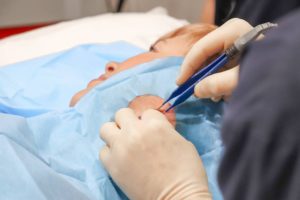Skin Tag Removal Auckland New Zealand by Dr Gittos Plastic Surgeon
Roughly 50% to 60% of adults develop at least one skin tag in their lifetime and the odds of a skin tag skyrocket after the age of 40. Skin tags, however, are a lot more prevalent in people with diabetes, obesity, or a history of skin tags. Of course, adults aren’t the only ones who have to deal with skin tags. These issues can also occur in teenagers. Even now, the incidence rates in adolescents and children are increasing. If you want skin tag removal, then Dr Gittos can help place.
Dr Mark Gittos is a specialist plastic surgeon based in Auckland with other clinics around New Zealand. With years of experience, Dr Gittos can safely remove your skin tags and give you the results you’ve been looking for. Check out the information below to find out more about the skin tag removal procedure, as well as some practical information on skin tags that you will find useful.
Skin Tags – What Are They, Exactly?

Skin tags are lesions, also referred to as ‘acrochordons.’ They grow in spots where you have skin folds and friction. They could appear on the eyelid, neck, groin, under the shoulder joint, and so on. These lesions can look like red, brown, or skin-coloured growths. They dangle over a fleshy stalk.
Skin tags are classified based on the following general description:
- Small skin tag: When the lesion is about 1-2 mm big, it is considered small. They frequently occur beneath the shoulder joint where the arm connects to the shoulder. And the neck as well
- Medium skin tag: A medium-sized lesion is around 5 mm long and 2 mm wide. It can occur in other areas of the body
- Large skin tag: This is a pedunculated lesion that can be relatively big. It may look like a bag like, soft fibroma that typically affects the groin
Even if skin tags are super small (around 1-5 mm in length), they can grow to be as large as 1 to 2 cm in size. They won’t necessarily cause pain. But, they can be a real nuisance to deal with. Many of our patients complain that their skin tags get caught up in their necklace, jewellery or clothes.
This kind of rubbing and friction can lead to itchiness and bleeding. Especially if your skin tag is located in a very troublesome spot and it constantly touches garments and sharp jewellery. That’s where a skin tag removal procedure can really help.
Note: People with specific genetic conditions could have a predisposition to skin tags. In individuals with tuberous sclerosis and BHD (Birt-Hogg-Dube) syndrome, skin tags can be seen in much bigger numbers.
Options for Skin Tag Removal
Not all skin tags must be removed. If the lesion doesn’t hurt or bother you, you may not need treatment. As a matter of fact, there is no need to treat the acrochordon unless it’s causing you problems.
Consider getting it removed if the lesion bleeds and gets irritated easily. Or, the way it looks bothers you. Book an appointment with Dr Mark Gittos to find out if your skin tag needs removing.
Our team of skin professionals can accurately diagnose your problem and offer you practical advice on how to get it under control. The skin tag removal procedure begins with an anaesthetic. This is to make sure that you have a comfortable experience. And various methods can be used to remove a skin tag.
Want to know what happens during the removal process?
Your skin tag removal process could include the following options.
1. EXCISION – Surgically Cutting the Skin Tag off
When done in a medical setting, a scalpel (or surgical scissors) can be used to cut it off. These are sharp and sterile utensils, capable of providing a fast result with minimal discomfort. To start the procedure, Dr Mark Gittos will clean the area thoroughly around the lesions.
They will then apply some topical anaesthetic. The properties in the product create a numbing effect, providing patients with ultimate comfort. After that, he will rely on a medical-grade scalpel or scissors to cut it off.
This cutting skin tag method is performed in the office. Don’t worry. He won’t cut too deep. Therefore, the treatment won’t cause any significant bleeding or scarring. You may experience some pain. But, the anaesthetic keeps most of the discomfort at bay.

2. ELECTRO SURGERY – Burning the Skin Tag Off
Typically referred to as Electrosurgery is the use of electric current to burn the lesion. Before the treatment begins, Dr Gittos will use a topical numbing gel. Then, he will place just the tip of the electrode on the affected area.
The heat produced from the current damages the skin tag’s tissues. It burns through the stalk, allowing it to fall off. The heat cauterizes the tiny wound, preventing bleeding. This is often a preferred method for those who are afraid of a scalpel or the cutting skin tag method.
3. FREEZING – Freezing the Skin Tag
Liquid nitrogen can be used to freeze a skin tag. A small amount of very cold liquid nitrogen can be applied to the affected area. It’s possible for the procedure to leave a tiny blister of where the skin tag once was. But, don’t worry. The skin will heal on its own.
What Other Lesions Can Look Like a Skin Tag?
There are a lot of skin conditions that can mimic a skin tag. To the untrained eye, they can be really confusing. These similar problems that can look like a skin tag include:
- Warts – Just like a skin tag, a wart is colourless. Unless that part of the skin that’s affected features a colour distinction. A wart also appears in areas with thick skin and doesn’t have any hair growing from it. The primary difference is that a wart is deep and thick. Whereas a skin tag will stay on the surface. What most patients don’t know is that a wart is contagious since it is caused by a virus. The possibility of it spreading to other areas of the body or other people is pretty strong
- Moles – Moles are brown and have soft skin. They aren’t contagious, but there is hair growing from them. Moles tend to occur in areas that have been exposed to the sun. Either from sun damage or genetics
- Cysts – A lump that’s filled with fluid that’s beneath the skin is known as a skin cyst. The surface is round and looks like a dome. It is potentially harmless and could dissipate on its own. The problem is it can be tricky to figure out if a lump is a cyst or something else. That’s why you should consult with a specialist
- Seborrheic keratosis – Growths with often a light, black, or brown colour that look scaly or waxy are seborrheic keratosis. They are benign and harmless. But can appear on the neck, chest, back, and face. These lesions can also get irritated by clothing and jewellery, which is why people confuse them for skin tags
- Milia – Tiny white bumps on the skin often grouped up together are milia. They develop when the skin flakes get trapped beneath the surface of the skin. These yellow or white bumps don’t often hurt or itch. But, they can be a little uncomfortable when they get irritated and red from rough clothing or sheets
- Neurofibromas – There are different types of Neurofibromas. They are usually soft bumps the size of a pea. They are not cancerous. But can grow inside the body or under the skin. Depending on its position and size, the Neurofibroma could lead to some form of disfigurement. Currently, there isn’t a cure for the condition, yet the symptoms can be managed. The sooner you consult a specialist, the better the outcome
- Nevus lipomatosus – These are very uncommon skin lesions that can be either solitary or multiple growths. Most of the time, they come in clusters of skin-coloured, yellow, and soft lesions. These lesions are quite lumpy and affect the upper thigh, buttocks, and lower back. Their surface is very wrinkled and could be hairy
Regardless of the type of skin problem you have, Dr Mark Gittos ad his team can take care of it.
Contact us today and book an appointment to keep your skin in good condition!

Skin Tag Removal FAQs
Why do I get skin tags?
- When an extra cell grows on the top layer of the skin, that’s when a skin tag starts to form. It tends to emerge with the rubbing of the skin, hence overweight people have plenty of skin tags. These lesions can form on the folds of the skin. Being predisposed to skin tags due to family history can also have an impact. But, it is not uncommon for pregnant women to get skin tags. But these types of problems often disappear after childbirth.
Do skin tags grow back?
- After the skin tag has been removed, it won’t grow back. You can, however, develop new skin tags in the meantime. The affected area could just be prone to having them.
What causes skin tags on the neck?
- Experts don’t know exactly what is triggering the problem. But, these lesions could develop due to the cluster of trapped blood vessels and collagen inside a thicker area of the skin. With skin folds and creases, like in the neck, the skin rubs itself against other areas of the skin. In obese individuals, excess weight around the neck and chest is a common problem.
Do skin tags spread?
- Yes they can spread. But, they are not contagious, like warts or other skin conditions. You won’t “catch” a skin tag from another person either. Nor can you spread it from one section of the body to the other. How skin tags spread will depend on what’s causing them and your susceptibility to these lesions.
Do skin tags grow?
- Skin tags are new growths on the skin. Even if they are not cancerous, they can easily be confused with other lesions that have the potential to be cancerous. If you are not sure about the type of growth you are dealing with, contact us today! We can take a closer look at your skin tag and offer you the treatment that can solve the problem.
Can you freeze a skin tag off with ice?
- People like to apply ice on the skin tag and wait for it to turn numb before they remove it. But, we don’t believe that’s a good idea. You can easily hurt your skin if you don’t know what you are doing. To get the ultimate results with minimal discomfort, we suggest you try cryotherapy. Applying super-cold liquid nitrogen in a doctor’s office can take care of the skin tag in a jiffy.
Is removing skin tags harmful?
- If you remove them by yourself – yes. You can hurt your skin, cause bleeding and probably scarring. If you use unsterile equipment or apply home remedies, you may not get the results you want. But, removing the skin tag in a medical setting isn’t harmful. Besides, a skin tag doesn’t have to be removed. If you choose to have it taken out, then do it with expert help.
Can I cut off a skin tag with nail clippers?
- No. Cutting the skin tag with nail clippers can lead to scarring, infection, and bleeding. Most home remedies for skin tag removal, like apple cider vinegar, tea tree oil, iodine, and many more, are unproven. For best results, contact a specialist. We can take care of the lesion and treat the skin with the latest and most successful methods.
Why choose Dr. Mark Gittos?
Dr. Mark Gittos is a leading Cosmetic Plastic Surgeon based in Auckland, New Zealand with years of experience in Mole Removal. He is a specialist plastic surgeon with recognition in the UK and Europe. He is a pioneer in the field of Plastic surgery and has contributed to the growth and expertise of other surgeons working in the field of plastic and cosmetic surgery. He uses advanced techniques to provide the most natural-looking results for breast, body, and skin surgeries.
Further Reading and Medical References
- https://www.ncbi.nlm.nih.gov/books/NBK547724/
- https://my.clevelandclinic.org/health/diseases/21528-skin-tags-acrochordons
- https://www.uofmhealth.org/health-library/abk9606
- https://www.epiphanydermatology.com/blog/how-to-tell-the-difference-between-skin-tags-moles-warts/
- https://www.nhs.uk/conditions/skin-cyst/
- https://dermnetnz.org/topics/naevus-lipomatosus-superficialis
- https://www.webmd.com/skin-problems-and-treatments/rm-quiz-truth-skin-tags
About Dr Mark Gittos FRACS (Plast) – New Zealand Plastic Surgeon
Practice locations in Herne Bay Auckland, Northland and Bay of Plenty – Kerikeri, Whangarei, New Plymouth & Tauranga
Dr Mark Gittos is a leading Specialist Plastic Surgeon and operates a practice in Herne Bay, Auckland and in the UK. The practice focuses on both surgical and non-surgical procedures, each designed to help restore, improve or change a physical characteristic or problem. The first step in every case is to talk through your personal requirements and explore all the options, before deciding on the most effective solution.
Dr Mark Gittos offers high quality, natural-looking cosmetic surgery results and is highly experienced in Breast, Body and Face Surgery having performed over 4000 Surgeries in the last 26 years. With worldwide expertise Dr Gittos is an expert in breast, face and body surgery for men & women.
Naturally, before any treatment is begun, we will explain clearly the advantages and risk factors; so that you have the information you need to make an informed decision that is best for you. Visit the practice to find out more.

NEXT STEPS
Do your Research
- Read the Website and Blogs relevant to your procedure
- Browse our Frequently Asked Questions including how to choose a Surgeon for your procedure
- Download and read the FREE Guides to Surgery
What to Bring to your Plastic Surgeon Consultation
- Bring a friend or relative to help discuss the information and your choices
- Take lots of notes and read the documents provided thoroughly
- Dress in simple clothes as you may need to undress for examination
- Bring your medical referral and any relevant medical documents or test results
Book your Initial Surgery Consultation
- A Referral from your GP or specialist is helpful but NOT essential – you can have a consultation without a GP Referral
- Email us or Call on 09 529 5352 to arrange your surgeon consultation appointment.
- Book a consultation with Dr Gittos by paying the Consultation Fee – $325 incl GST
Please contact us to arrange to book a consultation with our Specialist Plastic Surgeon or to speak with our Patient Care Advisor.
Send an enquiry form today or phone 09 529 5352 during Clinic Hours
